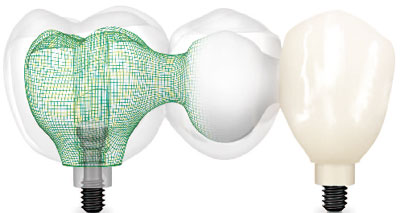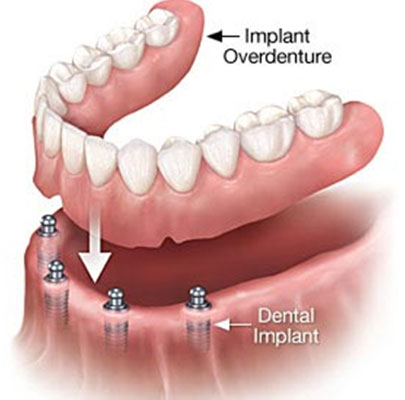
Dental implant placement procedure
It may sound too good to be true, but it’s not… all you need to do is come into the Implant Center at Dental Associates, sit down, and relax. In most situations, a 3D CT scan is used with virtual planning software to plan the implant placement and the design of the replacement teeth, even before the procedure itself starts. This is done after the initial examination and, if needed, allows for temporary replacement teeth to be ready for you the day of surgery.
And be assured that you will get outstanding, professional care. First, you’ll be made comfortable with the recommended sedation option. If necessary, any tooth extractions that need to be done will be done just prior to implant placement. After any teeth are removed, dental implants will be placed in the jaw bone using a gentle surgical technique. Replacement teeth will then be placed onto the implants. You’ll leave the office with your teeth, all in one appointment!
In some instances, you and your doctor may decide that a more traditional approach to implant placement is best. With a traditional type procedure, after the implants are placed, they will be left undisturbed for a period of several weeks to a few months while the surrounding bone and soft tissue heal. During this bone-remodeling phase, the bone will grow and the tissue will shape around the implants to form a strong biological bond. Temporary teeth will be placed on the implants, though, so you will never leave the office without teeth.
If your situation calls for the All-on-4 procedure, if you’re missing all your teeth or want to get rid of the pain of dentures, you’ll leave the office that day with a beautiful provisional dental implant-supported bridge. This is a temporary dental implant bridge designed to last up to 6 months. This 6-month period will allow for the bone in your jaw to heal and will allow time for the permanent implant-supported bridge to be made. In no longer than 6 months, you will get your permanent fixed teeth that will fit you perfectly. In the meantime, your temporary teeth will look and feel like real teeth. They’ll look great, and they’ll allow you to begin regaining your old eating habits. You’ll immediately see a revitalized appearance and develop a renewed self-confidence!
Restorative process
the appropriate bone remodeling/healing period, a small connector post called an abutment is attached to each implant. The temporary teeth, and eventually the permanent replacement teeth, will be attached to these abutments.

Fabrication of permanent replacement teeth
The Dental Implant Center at Dental Associates has a custom dental laboratory that is fully equipped to make your temporary teeth and your final teeth. Impressions will be taken of your new teeth as well as the implant abutments. The appropriate shade for your replacement teeth, as decided by you and your doctor, will be selected and our highly skilled technicians will fabricate your replacement teeth and the underlying structures that will be attached to the implants. This process can be done the same day as the implant procedure, or one to two weeks depending on the treatment option, number of missing teeth and the type of replacement teeth.
Maintenance and follow-up
You’ve made the decision, the right decision, to get dental implants to create a permanent, lifelong smile. It’s important to protect your new smile. But, that’s easy. Just brush and floss at least twice daily, and have regular check-ups and cleanings at Dental Associates. Your dental implants look and act just like real teeth. Treat them as you would your natural teeth, and you’ll have a beautiful smile for life.
All-on-4 procedure
This unique implant dentistry procedure is very appealing to people who are missing all their natural teeth, have weak and broken teeth and/or are wearing dentures. After the initial consultation and 3D imagining and planning, patients who qualify for this procedure can replace both an upper or lower denture with just four implants and get a full set of replacement teeth in as little as one clinical appointment. The All-on-4 procedure is also normally done without any bone grafting or other ancillary procedures, so it is a quick, efficient, cost-effective means to getting a permanent, life-long smile. Click here for more information on the All-on-4 procedure.
Whether you’ve lost a tooth, or teeth, due to an injury, illness or simple wear, you know the loss affects more than just your mouth. It affects your physical appearance, self worth, and quality of life. You can regain all that you lost with dental implants. Dental implants, a natural looking solution for tooth replacement, are state-of-the-art dental technology, and the only solution that replaces the entire missing tooth as well as preserves supporting bone. This makes dental implants the preferred choice over tooth supported fixed bridges or dentures. And because dental implants act as natural tooth roots, they help maintain the integrity of the jawbone and enhance your physical appearance. If you’re missing one tooth, many teeth, or all of your teeth, dental implants are the optimal choice for your overall health, self-confidence, well being and quality of life!
Implant supported fixed dentures are a way to replace teeth when all or most of the teeth are missing on the upper or lower jaw. This type of prosthesis is sometimes used when a patient cannot tolerate the palate being completely covered. It is more comfortable with less material in the mouth. In the upper jaw, we usually need to have six to eight dental implants while in the lower jaw we can usually use four to five implants. The prosthesis consists of a metal frame screwed onto the implants with teeth and pink plastic added to simulate the teeth and gums. Dr. Frey can remove the appliance by loosening the screws. This is only needed occasionally for maintenance and sometimes for more thorough cleanings. This type of denture is not removable by the patient and since the implants that it is attached to are fused directly to the bone, these tooth replacements are as solid as the original teeth. The chewing power of this denture is much greater than a conventional denture. It is equal to the chewing power of natural teeth.

Implant Supported Removable Dentures
Many people that wear complete upper and lower dentures are unhappy with them. Lower dentures never fit or feel like natural teeth. The good news is that dentures retained by dental implants can solve this problem. Implant supported dentures provide tremendous support and fixation so eating, speaking and smiling is more comfortable. Patients with loose lower dentures are great candidates. Dr. Frey recommends as little as two implant fixtures to hold the denture so that it no longer “floats” around causing soreness and difficulty with chewing.
The Implant Process
The implants usually are placed in the jawbone at the front of your mouth because there tends to be more bone in the front of the jaw than in the back. This usually is true even if teeth have been missing for some time. Once you lose teeth, you begin to lose bone in the area. Also, the front jaw doesn’t have many nerves or other structures that could interfere with the placement ofimplants.
The time frame to complete the implant depends on many factors. The shortest time frame is about five months in the lower jaw and seven months in the upper jaw. This includes surgeries and the placement of the denture. However, the process can last a year or more, especially if you need bone grafting or other preliminary procedures.
Two surgeries usually are needed. The first one places the implants in the jawbone under your gums. The second surgery exposes the tops of the implants. The second procedure comes three to six months after the first.
A one-stage procedure is now used sometimes. In this procedure, your dentist can place the implants and the supporting bar in one step. The success rate of this procedure is high.
Removable Implant-Supported Tooth Replacement: If all of your lower teeth are missing, depending on the design of the removable restoration, two to six implants may be used to support a lower denture. If all of your upper teeth are missing, a minimum of four implants may be used to support an upper denture. Removable dentures are often used to replace extensive tooth, bone and gum-tissue loss, thus providing support for the facial skeleton, lip and cheeks. A new denture can have attachments that snap or clip it into place on the implants or a custom made, milled bar can be fabricated to create additional strength and support for the restoration. Design variations are often related to your bone density and number of implants present; your dentist will discuss these options during your consultation. A significant advantage of a removable denture is facilitating the cleaning of the dental implants.

